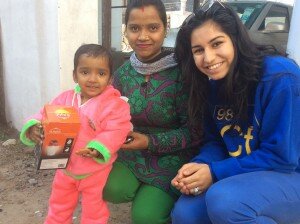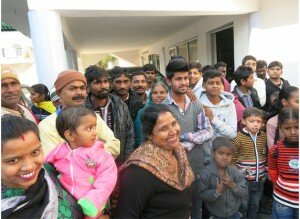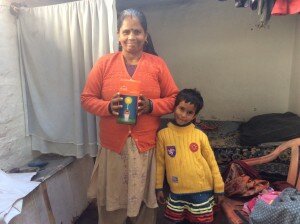By: Kirpa Wirk, February 2015
Kirpa Wirk of Santa Cruz, a senior at University of California Santa Cruz, has long been passionate about passing on knowledge.  She was inspired by the work of non-profit organizations broadening educational horizons of students around the world, and pursued to become a Global Ambassador for One Million Lights. In December 2014, Kirpa and her friend Ali headed to Kishen Garh, India to distribute 50 solar lanterns.
She was inspired by the work of non-profit organizations broadening educational horizons of students around the world, and pursued to become a Global Ambassador for One Million Lights. In December 2014, Kirpa and her friend Ali headed to Kishen Garh, India to distribute 50 solar lanterns.
The excitement that ran through our bodies, as we got ready for our distribution of lights in the morning of December 30, 2014 laid heavy on our hearts and senses. We didn’t really know what to expect from the village people whom we were going to enlighten with solar lanterns and provide a substitution (supplementary) source of light in their village where there is extremely erratic electricity.
Before planning our Global Ambassador experience we researched about areas in India that had a lack of or unreliable light source. We chose Kishen Garh because it was a place that lay outskirts of developing cities trying to catch up with its developing surroundings.
 We arranged with the pandhit (priest) of the village temple to distribute lights as he was the community figure that people looked up to and he could explain the use and advantages with using these lights. The Sarpanch (community leader) Gurwinder K Labana arranged tea and snacks for people coming to learn about the lights’ use and to receive one for their family.
We arranged with the pandhit (priest) of the village temple to distribute lights as he was the community figure that people looked up to and he could explain the use and advantages with using these lights. The Sarpanch (community leader) Gurwinder K Labana arranged tea and snacks for people coming to learn about the lights’ use and to receive one for their family.
Ali and I brought a reliable solar light that could extend productive hours of the day for children, adults and the elderly. The message of this opportunity of light spread quickly and everyone in the village was there at our demonstration to watch and see what, how and why it was being used and brought to them.
As we approached the village temple, where the distribution had been arranged to take place, we were welcomed with a crowd of people of all ages – elderly, adults and the youth – with amazement and curiosity.
We set up a stand in the temple where we gave a demonstration of what solar energy is, how solar lights use energy from the sun to illuminate, how it could extend community members productive hours of the day and how it is important that we educate ourselves and other on electricity alternatives (i.e solar, wind, hydro).
The crowd slowly grew as we progressed with our demonstration and began to interview and distribute one light per family. The interest of solar sparked in the community member’s eyes. The simplicity of harnessing the energies sun for their own beneficial use without paying an electricity bill blew them away. The children were all lined up with wide eyes and big smiles ecstatic to be given a light that could potentially change their future. One of the young girls, Shella, who was 16 years old told me that these lights have the prospects to change her life and give opportunities for her to grow and keep up in school, and maybe even have the opportunity to leave the village to go to higher educational institutes. She told me that she could now do homework in her room with the light rather than having to sit under the street lights at night to read her text books.
interest of solar sparked in the community member’s eyes. The simplicity of harnessing the energies sun for their own beneficial use without paying an electricity bill blew them away. The children were all lined up with wide eyes and big smiles ecstatic to be given a light that could potentially change their future. One of the young girls, Shella, who was 16 years old told me that these lights have the prospects to change her life and give opportunities for her to grow and keep up in school, and maybe even have the opportunity to leave the village to go to higher educational institutes. She told me that she could now do homework in her room with the light rather than having to sit under the street lights at night to read her text books.
“Usually I study under the street lamp when the electricity goes out. Now I will be able to continue my studies indoors” – Shella (16)
The Sarpanch (community leader) told us that “the lights will be good for the poor who struggle to pay for both food and electricity -this will also raise awareness for solar power”. The community leader was happy to see the solar lights being given away to those with a greater need – children, store keepers, elderly – because it was bringing their community together.
The use of these lights was primarily to supplement their erratic electricity. The smiles and happiness felt from the villagers when we began to distribute them left a handprint on our hearts.
 The children of the village now have the possibility to study and move out of the village to go to higher educational institutes. The workers in the village can extend their productive hours. And families can now sit under an illuminated solar light to enjoy more brightened hours together.
The children of the village now have the possibility to study and move out of the village to go to higher educational institutes. The workers in the village can extend their productive hours. And families can now sit under an illuminated solar light to enjoy more brightened hours together.
There is definitely a need of reliable consistent electricity in the village of Kishen Garh. The first step was educating the people and distributing lights per family.
My hopes are to go back and distribute more lights one day, as there were many families that could benefit from solar lights. Many of the people didn’t know what a solar light was until my demonstration. Once they saw the splendors of light being generated by the sun, they wanted it.
One Million Lights mission aims for better standards of living through education. I hope to contribute more to the 1,000,000 light goal and actively participate within One Million Lights in the upcoming years. This experience has taught me a lot about the power of education, people, wiliness and dimensions of differing societies.
One Million Lights changes lives. Join the movement today and please donate to keep illuminating lives of humans around the globe.
